SUNEKOS
Dermal design
Dr Rita Nandi presents a Sunekos treatment journey on a patient with prior negative experience of injectables

Before
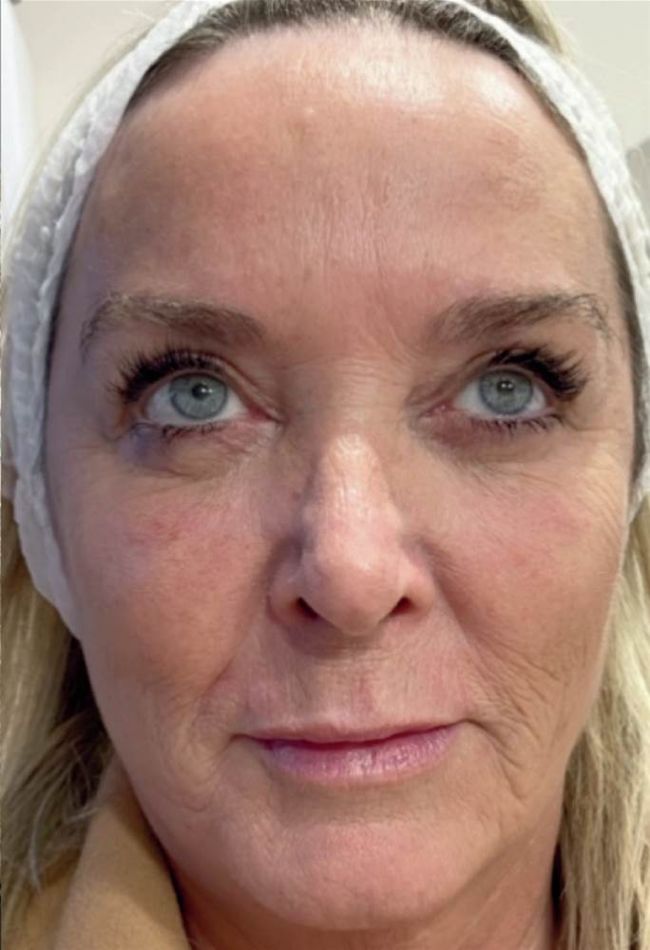
One week after fourth session
Sunekos 200 is a class III medical device injectable treatment which has been formulated to tackle signs of ageing in the face and body by directly targeting the extra cellular matrix (ECM) and its components. Sunekos 200 contains hyaluronic acid 200kDa which acts on specific receptors present in the cell membrane to potentiate fibroblast activity. To promote the production of fibrous proteins there needs to be specific amino acids present – think of them as the right fuel or nutrientswhich the fibroblast needs in order to produce collagen and elastin.
Upon injection, Sunekos 200 gives rise to a natural regeneration of the dermal tissue known as dermal biogenesis. It does this through regeneration of the ECM using a unique patented combination of hyaluronic acid along with specific amino acids which lead to new collagen and elastin production. Collagen and elastin form a large bulk of the ECM. The homeostasis of the ECM is crucial for the optimal functioning of cells and organs. In the skin, the largest organ of the human body, when ECM homeostasis is lost, this leads to ageing. The main reasons for this are a reduction in the number and activity of fibroblasts (leading to less collagen and elastin within the ECM) and loss of hydration.
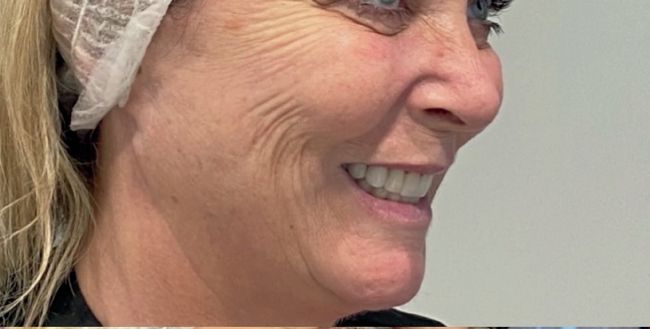
Before
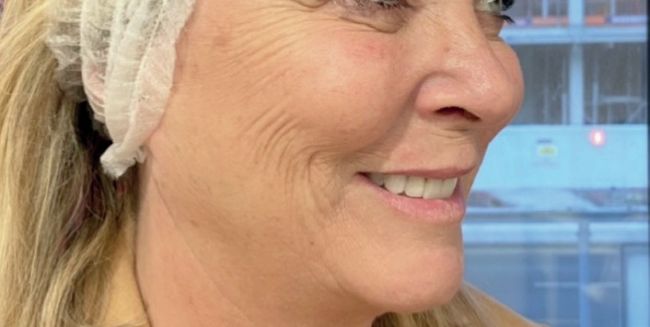
One week after fourth session
CONSULTATION
My 59-year-old female patient came to see me concerned with fine lines and wrinkles over her cheeks and lower face, skin laxity and dullness. She had been treated with botulinum toxin in the past and Profhilo around five months prior to presenting to clinic, but reported she had not seen much of a difference. She had also received cheek filler 16 months prior and complained that she was unhappy with the result; she felt they had been over-filled. Having been dissatisfied with these treatments, she already knew about Sunekos and was keen to try it. On examination, she had good volume to her cheeks, but I noted signs of sun damage with fine lines, wrinkles and skin laxity. She was largely fit and well other than having mild osteoarthritis in her right knee, for which she had been treated with steroid injections and was not on any regular medication. She had no allergies. I recommended her to have Sunekos 1200 in addition to Sunekos 200 to provide additional support, but she was very reluctant to inject a thicker hyaluronic acid product into her cheeks in case they appeared more volumised, as she had previously experienced.
The patient was happy to proceed with four sessions of Sunekos 200. Her treatment sessions were spaced 9 to 14 days apart, except for her third treatment session which was 19 days after her second. This was because she went on holiday abroad and I thought it better to treat her after her holiday rather than just before. Other than going on holiday and getting a little tanned, she denied any change in her lifestyle (e.g. diet and exercise) during her treatment course.
TREATMENT PLAN
Sunekos 200 comes in a box consisting of two parts; a small glass vial of the amino acids glycine, L-proline, L-lysine, L-alanine, L-valine and L-leucine in a powder form, and a vial containing sodium hyaluronate (30mg in 3ml of distilled water). Sunekos is manufactured by Professional Dietetics and can be bought via Med-fx pharmacy in the UK. The non-cross linked low-molecular weight hyaluronic acid is mixed into the vial containing the amino acids and injected into the face or body where it promotes new collagen and elastin formation through activating fibroblast activity in the injected area. Study data has shown that Sunekos reduces the appearance of lines and wrinkles, improves skin hydration, smoothness, brightness and suppleness as well as improving cheek volume and the facial silhouette through having a plumping and lifting effect.1,2
Sunekos is also available in a 1200 variant, indicated for use in patients with severe wrinkles and damaged skin. It is intended to be used in combination with Sunekos 200 as a boost for such patients as the two used together improves volume better than Sunekos 200 alone. However, Sunekos 200 can effectively be used on its own in younger patients to stimulate the production of collagen and elastin and enable new extra cellular matrix to be formed. It is suitable for all types of skin and can be used in different areas of the body including the face, neck, décolleté and hands. It can also be a very effective solution to help treat common periocular concerns such as dark circles and bags.
Each treatment session involved injecting the medium-deep dermis at various points and was completed within 15 minutes or so. Results have been shown to improve when injecting Sunekos 200 using the interstitial fluid technique (IFT) or reverse interstitial fluid technique (RIFT). IFT is indicated in relatively younger and elder round-faced patients who benefit from a lifting effect, while RIFT is intended for patients who have a slender, more sunken face who would benefit from a volumising effect. Both techniques use the flow of interstitial fluid to help disperse the product to areas where it is more needed.3 I used IFT with my injections for this patient during each treatment session to help optimise results and bring about a lifting effect, as she had a round face with sagging skin.
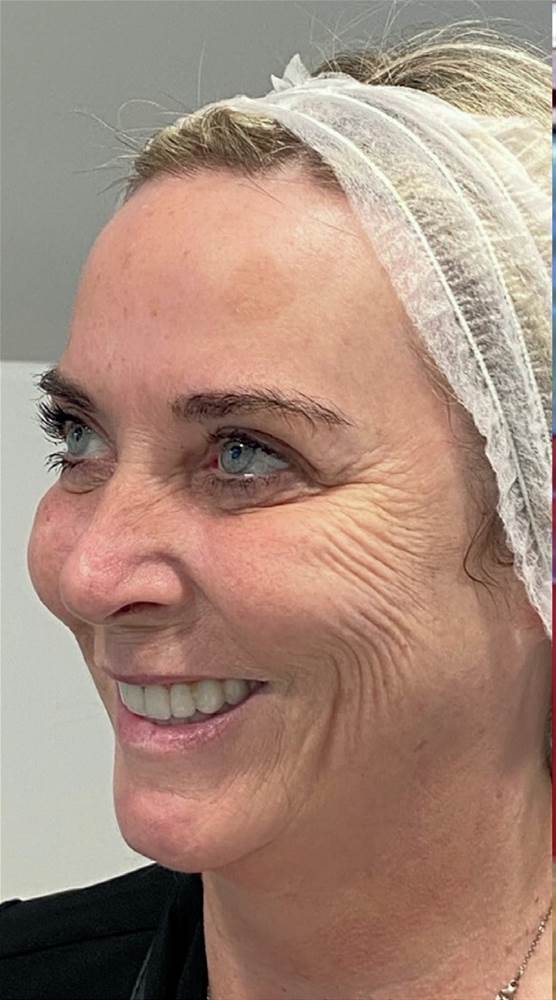
Before
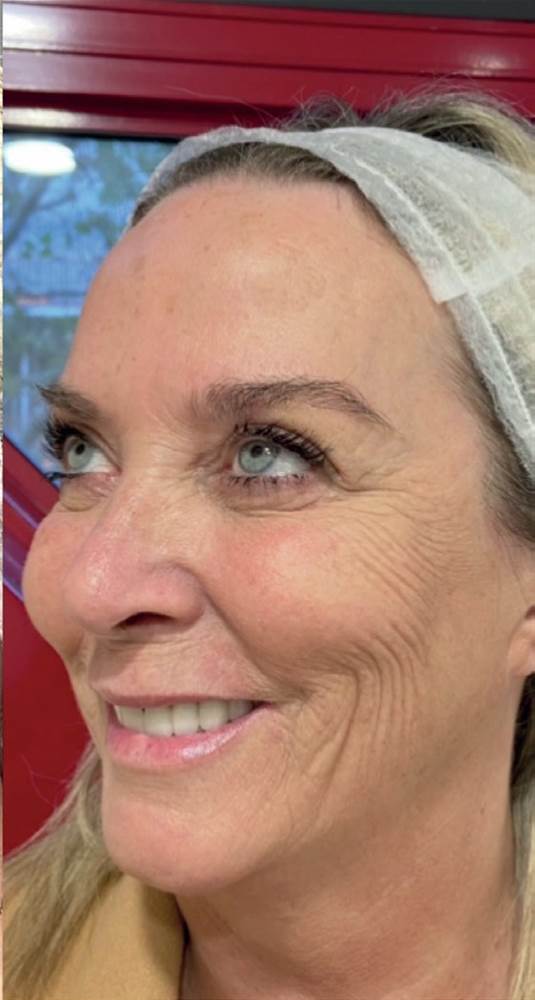
One week after fourth session
I applied LMX topical anaesthetic cream for 20 minutes prior to the injections in each session. The patient rated her pain score during her treatment as a 3/10 severity, other than her upper lip which she scored as 6/10. She reported that the treatment was generally well tolerable.
Downtime is minimal with Sunekos 200 and the patient can resume their day as normal other than some minor aftercare such as keeping the face clean and avoiding touching the injected areas for the rest of the day.
RESULTS
Although Sunekos 200 is often given as a course, it is common for patients to see some improvement after the first session. If patients have a course of four sessions, they should expect to see results last for up to six months before needing to repeat the procedure. The patient reported that she could already see improvements to her skin after the fourth session but was advised that she would see further improvements to her skin up to six months after her initial treatment. She said that she had noticed a bigger improvement to her skin with Sunekos than with the Profhilo treatment she had previously with a different practitioner, of which she had two sessions. She reported she would like to tackle the fine lines and wrinkles over her lower face through microneedling as her next treatment. I have also recommended for her to use medicalgrade skincare at home to improve the general condition of her skin in between clinic treatments.
REFERENCES
1. Sparavigna A, Orlandini A, “Efficacy and Tolerance of an Injectable Medical Device Containing Hyaluronic Acid and Amino Acids: A Monocentric Six-Month Open-Label Evaluation’, Journal of Clinical Trials, (2017), 7:316
2. https://www.sunekos.com/wp-content/uploads/2019/11/INJECTION_TECHNIQUES_ ALGORITHM.pdf
3. Sparavigna A. The Interstitial Fluid Technique and the Extracellular Matrix. Prime Journal (Jan/Feb 2019)
DR RITA NANDI
Dr Rita Nandi is a cosmetic doctor and an NHS GP. She has 14 years’ experience as a doctor and currently practices medical aesthetics and cosmetic dermatology at The Bloom Clinic in Canary Wharf, London. She has completed a Level 4 qualification in Cosmetic Dermatology at Harley Academy and is currently studying for the Level 7 Injectables Diploma. Follow her on Instagram: @the_bloom_clinic